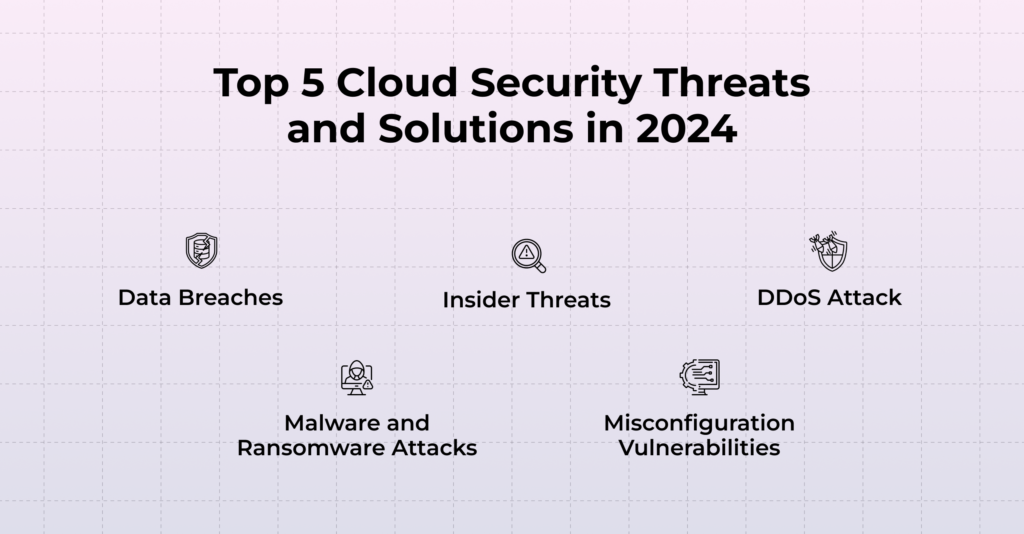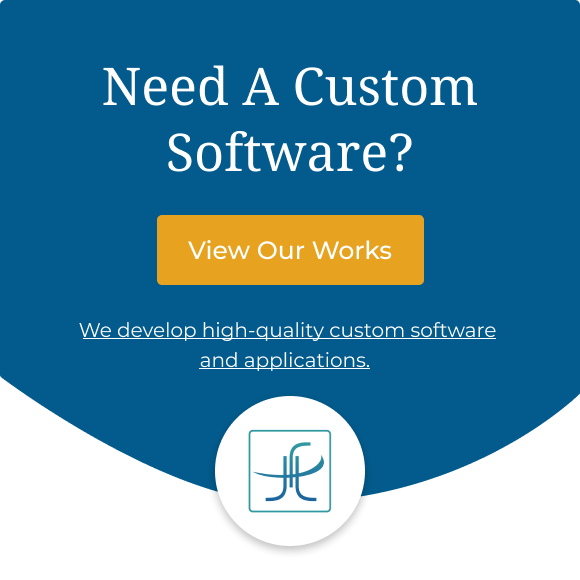According to Statista, revenue in the cloud security market is projected to reach US$2.31 billion in 2024 and is expected to show an annual growth rate (CAGR 2024-2028) of 37.93%, resulting in a market volume of US$8.36 billion by 2028.
Despite the advancements in cloud security, businesses still face the persistent threat of breaches and vulnerabilities, with data loss and accidental leaks of credentials among the foremost concerns.
In this blog, we will delve into the top five cloud security risks anticipated for the upcoming years and strategies to mitigate them. However, before delving into these risks, it’s essential to gain a comprehensive understanding of what cloud computing entails.
Understanding Cloud Computing
Cloud computing is a transformative technology that revolutionizes how organizations access, store, and manage data, applications, and IT resources over the Internet. Instead of relying on local servers or personal computers to handle computing tasks, cloud computing enables users to leverage remote servers hosted in data centers operated by third-party providers. At its core, cloud computing is characterized by five essential characteristics. Let’s take a quick look at them.
On-Demand Self-Service
Users can provision computing resources, such as storage, processing power, and applications, without requiring human intervention from the service provider.
Broad Network Access
Cloud computing services are accessible over the internet from a variety of devices, including laptops, smartphones, and tablets, enabling ubiquitous access to computing resources.
Resource Pooling
Cloud computing providers aggregate computing resources across multiple users, allowing resources to be dynamically allocated and reallocated based on demand.
Rapid Elasticity
Cloud computing resources can be rapidly scaled up or down to accommodate fluctuations in workload, ensuring optimal resource utilization and performance.
Measured Service
Cloud usage is monitored, controlled, and metered, enabling users to pay for the resources they consume on a pay-as-you-go or subscription basis.
Understanding Cloud Security
Cloud security refers to the set of policies, technologies, and controls implemented to protect cloud computing environments, data, applications, and infrastructure from cyber threats and unauthorized access. It encompasses measures to ensure the confidentiality, integrity, and availability of data and resources stored and processed in the cloud.
Cloud security aims to address various security challenges unique to cloud computing, such as shared responsibility models, multi-tenancy, and the dynamic nature of cloud environments.
Let’s now delve into the benefits of cloud computing and the imperative need for robust cloud security across various industries.
Cloud Computing Benefits & Security Needs Across Industries
Cloud computing offers a myriad of benefits to organizations across diverse industries, ranging from enhanced scalability and flexibility to cost savings and improved collaboration. However, alongside these benefits come inherent security risks that must be addressed to safeguard sensitive data and maintain operational integrity.
Healthcare Industry
In the healthcare industry, cloud computing facilitates the seamless exchange of electronic health records (EHRs) and enables telemedicine platforms, enhancing patient care and operational efficiency. However, the confidentiality and integrity of patient data necessitate stringent cloud security measures to prevent data breaches and safeguard sensitive medical information.
Discover the transformative impact of cloud computing on the healthcare sector in our latest blog: How Cloud Computing Is Benefiting The Healthcare Industry?
Education Sector
Educational institutions embrace cloud computing to deliver online learning platforms, streamline administrative processes, and facilitate collaborative learning experiences. However, the proliferation of cloud-based educational tools introduces security risks such as unauthorized access and data breaches. Implementing robust cloud security measures is crucial to safeguard student data and ensure compliance with privacy regulations.
Bespin Labs Partners With Jellyfish Technologies To Launch Patronum, Revolutionizing Google Workspace Management And Enhancing Organizational Efficiency
Retail Industry
Retailers leverage cloud computing to optimize inventory management, personalize customer experiences, and drive online sales. However, the interconnected nature of cloud-enabled retail ecosystems exposes organizations to cyber threats such as payment fraud and supply chain vulnerabilities. Securing cloud infrastructure against these threats is essential to protect customer data and preserve brand reputation.
Financial Services Sector
The financial industry leverages cloud computing to streamline banking operations, enhance customer experiences, and drive innovation. However, the vast amounts of financial data stored in cloud environments make banks and financial firms prime targets for cyberattacks. Robust cloud security measures are essential to protect against threats, such as ransomware attacks, insider threats, and data breaches.
Manufacturing Sector
Manufacturing companies adopt cloud computing to streamline production processes, improve supply chain visibility, and enhance operational efficiency. However, the digitization of manufacturing operations introduces security risks, such as intellectual property theft and industrial espionage. Robust cloud security measures are essential to protect trade secrets and maintain the integrity of manufacturing processes.
Government Sector
Government agencies embrace cloud computing to enhance citizen services, modernize IT infrastructure, and drive digital transformation initiatives. However, the sensitive nature of government data makes public sector organizations vulnerable to cyberattacks. Implementing robust cloud security measures is essential to protect national security interests and uphold public trust in government institutions.
Transportation and Logistics Industry
Transportation and logistics companies leverage cloud computing to optimize route planning, track shipments, and improve supply chain efficiency. However, the reliance on cloud-based logistics platforms introduces security risks such as data breaches and supply chain disruptions. Securing cloud infrastructure against these threats is essential to ensure the reliability and resilience of transportation networks.
Hospitality Sector
The hospitality industry adopts cloud computing to streamline hotel operations, enhance guest experiences, and drive customer loyalty. However, the vast amounts of guest data stored in cloud environments make hospitality companies prime targets for cyberattacks. Robust cloud security measures are essential to protect guest privacy and maintain trust in hospitality brands.
Energy and Utilities Sector
Energy and utility companies embrace cloud computing to optimize energy distribution, monitor infrastructure, and facilitate smart grid initiatives. However, the digitization of critical infrastructure introduces security risks such as cyberattacks targeting cloud-based control systems and IoT devices. Securing cloud environments against these threats is essential to ensure the reliability and resilience of energy networks.
Telecommunications Industry
Telecom companies leverage cloud computing to support network infrastructure and deliver innovative services such as 5G connectivity and IoT solutions. However, the interconnected nature of cloud-enabled telecom networks exposes operators to cyber threats such as DDoS attacks and network breaches. Robust cloud security measures are essential to safeguard critical infrastructure and protect customer data in the telecommunications industry.
If you’re keen on exploring the myriad benefits of cloud computing in the telecom industry, you’ll find this article insightful: A Guide to Cloud Computing in the Telecom Industry: Types, Modals, Benefits, & Trends
Top 5 Cloud Security Threats and Solutions in 2024
Data Breaches
Threat
Data breaches are a persistent concern for organizations operating in cloud environments, as cybercriminals continuously exploit vulnerabilities to access sensitive data. Whether through unauthorized access, compromised credentials, or insecure APIs, data breaches can have severe consequences for organizations, including financial loss, reputational damage, and regulatory penalties.

Solution
To mitigate the risk of data breaches, organizations should implement robust encryption mechanisms to protect data both in transit and at rest. This includes encrypting sensitive data stored in cloud databases and encrypting communications between cloud services. Additionally, organizations should enforce strict access controls and implement multi-factor authentication (MFA) to prevent unauthorized access to cloud resources.
Moreover, regular security audits and vulnerability assessments can help identify and remediate potential weaknesses in cloud infrastructure, reducing the risk of data breaches.
Insider Threats
Threat
Insider threats, whether malicious or unintentional, pose a significant risk to cloud security. Malicious insiders with privileged access to cloud resources can steal sensitive data, sabotage systems, or engage in espionage activities.
Additionally, unintentional insider threats, such as employees falling victim to phishing attacks or accidentally exposing sensitive information, can also compromise cloud security.
Solution
Organizations can mitigate the risk of insider threats by implementing least privilege access controls, ensuring that users only have access to the resources and data necessary to perform their roles. Furthermore, user activity monitoring and behavior analytics can help detect suspicious behavior indicative of insider threats, allowing organizations to respond promptly.
Employee training and awareness programs are also essential to educate staff about the importance of data security and the risks posed by insider threats.
Malware and Ransomware Attacks
Threat
Malware and ransomware attacks targeting cloud environments are becoming increasingly sophisticated and prevalent. These attacks can exploit vulnerabilities in cloud infrastructure, compromise user credentials, or infect cloud-based applications, leading to data loss, system downtime, and financial extortion.
Solution
Organizations should deploy advanced endpoint protection solutions capable of detecting and mitigating malware threats in real time. Intrusion detection and prevention systems (IDPS) can help identify and block suspicious network traffic associated with malware and ransomware attacks. Regular security updates and patches should be applied to cloud infrastructure to address known vulnerabilities and minimize the risk of exploitation by cyber adversaries.
Additionally, organizations should implement robust backup and recovery strategies to ensure data availability in the event of a ransomware attack, enabling them to restore operations quickly.
Misconfiguration Vulnerabilities
Threat
Misconfigurations in cloud infrastructure settings can inadvertently expose sensitive data to unauthorized access or compromise the integrity of cloud-based applications.

Common misconfigurations include insecure storage settings, weak access controls, and improper network configurations, all of which can create opportunities for attackers to exploit.
Solution
Organizations should implement automated configuration management tools to enforce standardized security configurations across cloud environments. These tools can help ensure that cloud resources are configured according to security best practices and compliance requirements. Furthermore, regular audits of cloud infrastructure settings should be conducted to identify and remediate any misconfigurations promptly.
Cloud security posture management (CSPM) solutions can also be employed to continuously monitor cloud environments for compliance with security policies and regulatory standards.
DDoS Attacks
Threat
Distributed Denial of Service (DDoS) attacks targeting cloud service providers can disrupt access to critical resources and impact the availability of cloud-based applications and services. These attacks overwhelm cloud infrastructure with a flood of traffic, rendering services inaccessible to legitimate users.
Solution
Organizations can mitigate the risk of DDoS attacks by leveraging cloud-based DDoS protection services offered by reputable providers. These services typically include traffic filtering, rate limiting, and scrubbing capabilities designed to mitigate the impact of DDoS attacks in real time.
Additionally, organizations can implement network security measures such as ingress filtering and route optimization to reduce the attack surface and mitigate the risk of DDoS attacks targeting specific endpoints. Content delivery networks (CDNs) can also be used to distribute traffic and absorb DDoS attacks, ensuring the availability of cloud-based services during periods of increased traffic or attack activity.
Leverage Jellyfish Technologies’ Expertise for Secure Cloud Services
As organizations navigate the complexities of cloud computing and strive to safeguard their digital assets against evolving cyber threats, partnering with a trusted advisor is essential to achieve robust cloud security. Jellyfish Technologies stands as a leading provider of cloud computing services, offering tailored solutions to address the unique security challenges faced by businesses across diverse industries.
With our extensive experience in cloud computing consulting and cloud strategy consulting, we empower organizations to develop comprehensive cloud security strategies that align with their business objectives and regulatory requirements. Our team of experts collaborates closely with clients to assess their cloud environments, identify potential vulnerabilities, and implement robust cloud security measures to mitigate risks effectively.
Whether you’re looking to migrate to the cloud, optimize existing cloud deployments, or strengthen cloud security measures, Jellyfish Technologies is here to support you every step of the way. Contact us today to learn more about our cloud computing consulting services.


